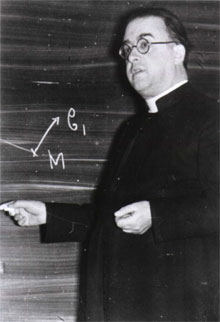
Lemaître at the Catholic University of L in Leuven, circa 1933.
Lemaître
Monseigneur Georges Henri Joseph Édouard Lemaître, (17 July 1894 – 20 June 1966) was the first to propose what is now known as Big-Bang Cosmology, the basis of all modern cosmology. On the basis of Einstein’s General Theory of Relativity he predicted the redshift of distant galaxies in 1927, confirmed by Hubble two years later in 1929 and codified in Hubble’s Law. He also predicted the value of Hubble’s constant.
His ideas were greeted by scepticism by Einstein, but after Hubble’s discoveries Einstein quickly recanted. However, it was not until Penzias and Wilson’s discovery of the Cosmological Microwave Background in 1963 that Lemaitre’s ideas came to be widely accepted.
Pope Pius XII considered that Lemaître's theory provided a scientific validation for Creationism and thus gave support to Catholic doctrines. Lemaître thought otherwise, and with Daniel O'Connell, the Pope's science advisor, successfully persuaded the Pope to refrain from linking Creationism to scientific discoveries in cosmology.
Lemaître was educated at a Jesuit secondary school in Charleroi, and studied civil engineering and later physics and mathematics at the Catholic University of Leuven. He was ordained as a priest in 1923, and in that same year travelled to Cambridge, England, where he worked with Arthur Eddington in cosmology and stellar astronomy. He spent the year 1924 in Cambridge, Massachusetts, at the Harvard College Observatory and at MIT. On his return to Belgium he took up a lectureship at his alma mater, and began work on his historic paper of 1927. An abbreviated version of it was published in English in 1931. In that year he also proposed that the universe expanded from an initial point, that he later called ‘The Primeval Atom’. It was pejoratively ‘the big bang theory’ by the Cambridge physicist Fred Hoyle, a proponent of the steady state theory of the universe.
